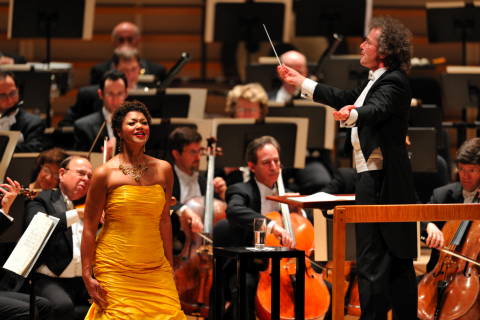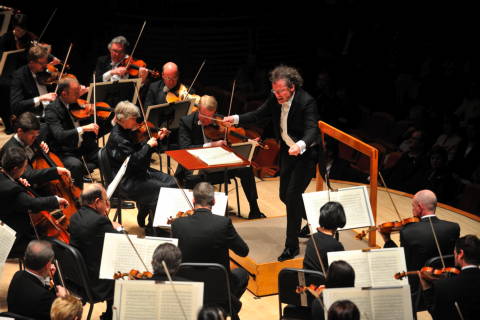|

A Passionate Attraction
The Cleveland Orchestra in Miami,
reviewed by LAWRENCE BUDMEN
The Cleveland Orchestra serves over twenty thousand adults and young people through its annual three week residency in Miami, Florida, USA. An expansive program of community outreach and educational activities are complemented by concerts at the Adrienne Arsht Center for the Performing Arts. For the opening concert of its third South Florida residency on 30 January 2009, the Clevelanders produced an awesome display of instrumental firepower in Dmitri Shostakovich's Symphony No 7 in C (Leningrad), an orchestral showpiece that only the best orchestras dare attempt.
The Clevelanders' ensemble sonority is simply magnificent; yet they play with the minutely nuanced attention to detail of the finest chamber music groups. Every section of this powerhouse band from the American Midwest conveys virtuosic strength and innate musicality. Player for player, Cleveland has the best first chair leaders of any US orchestral or operatic organization. This ensemble remains the most classical of American orchestras.

Measha Brueggergosman, Franz Welser-Möst and the Cleveland Orchestra perform Wagner's Wesendonck Lieder in Miami, Florida, USA on 30 January 2009. Photo © 2009 Roger Mastroianni
|
Scaled down to chamber orchestra proportions, the Cleveland musicians opened the program with Wagner's Wesendonck Lieder featuring Canadian soprano Measha Brueggergosman as soloist. Once a staple of the concert repertoire, these late 1850s songs are all too rarely heard today. Inspired by Wagner's passionate attraction to the poet Mathilde Wesendonck, these songs (to texts by Wesendonck) were the genesis of Tristan und Isolde, the composer's tragic tale of medieval romance. Like that opera, the Wesendonck Lieder abound in extroverted displays of overt emotion and impassioned yearning.
Wagner only orchestrated the final piece of the five song cycle. The other songs were arranged by the conductor Felix Mottl. The rich textures of dark lower strings are enhanced by glorious writing for horns and winds. Music director Franz Welser-Möst drew gorgeously sensuous tones from his stellar instrumentalists. The conductor's long experience in major European opera houses came to the fore in a model accompaniment, emotionally intense yet discreet.
Brueggergosman commands a voice of astounding colors and textures. From her first hushed tones in Der Engel ('The Angel') to the glorious blossoming of her radiant upper and middle registers in Schmerzen ('Anguish') and Traume ('Dreams'), Brueggergosman's intense articulation of the text was deeply emotive and riveting. She seemed to embody the journey of a tragic affair of the heart. The sheer radiance of this soprano's sizable instrument recalls the great Jessye Norman in her vocal prime. Brueggergosman sang with the kind of concentrated intensity and vocal beauty that spells greatness. This writer looks forward to hearing more from this exceptionally talented soprano, particularly in the Strauss repertoire.
Shostakovich's Seventh Symphony was composed in 1941 during the German siege of Leningrad, following the Nazi invasion of the Soviet Union. (Shostakovich worked in a fire brigade during the long blockade of the city.) While the Stalinist authorities were quick to appropriate this score for propaganda purposes, the music remains a powerfully emotional experience. Shostakovich seemed to encapsulate the suffering and resolve of the Russian people in the nearly seventy minute work. In a world besieged by terrorism and violence, Shostakovich's large scale essay remains timely and relevant.

Franz Welser-Möst and the Cleveland Orchestra play Shostakovich's Leningrad Symphony at Miami's Adrienne Arsht Center for the Performing Arts. Photo © 2009 Roger Mastroianni
|
Welser-Möst's performance was profoundly moving and stirring. This conductor displays the uncanny ability to illuminate textures and instrumental niceties that too often become obscured in more mundane performance. He enlivened the calm principal theme of the opening Allegretto with pensive agitation. The bolero episode was incredibly terrifying -- the composer's progressively louder and ominous reiteration of the theme symbolizing the approaching Nazi forces. With extra brass stationed in the choral bleachers, Welser-Möst built momentum gradually, leading to a final orchestral explosion of stunning impact. Under the conductor's masterly control the Moderato (second) movement seemed to register an agitated calm with sinister musical storm clouds constantly on the threatening horizon. The luminous beauty of Frank Rosenwein's solo oboe embraced the haunting principal melody.
This symphony's heart and soul rests in the Adagio, a heartfelt threnody for the dead. Led by concertmaster William Preucil, the Cleveland strings unleashed a wave of luminous textures, brought to an emotional boiling point by Welser-Möst. This harrowingly tragic music comes from deep in the Russian soul. (Like Musorgsky before him, Shostakovich seemed to telegraph that uniquely Russian sense of suffering. It is hardly accidental that Shostakovich made one of the most effective orchestrations of Boris Godunov, a version that remains true to its composer's harmonically austere vision.) The purity of Joshua Smith's flute solos and the surprisingly mellow bassoon interjections of John Clouser displayed the pristine beauties of the acclaimed Cleveland winds. This barren evocation of tragedy became the appropriate high point of Welser-Möst's monumentally compelling performance.
The conductor pulled out all the stops for the final hymn of triumph, the symphony's opening theme returning in a round of majestic fanfares. Welser-Möst's masterly control produced a climax of blazing exuberance -- the triumph of the human spirit. This iconic Shostakovich score offered the Welser-Möst-Cleveland collaboration at its formidable best.
Copyright © 4 February 2009
Lawrence Budmen, Miami Beach, USA

The Cleveland Orchestra returns to Miami's Arsht Center on 6 and 7 March 2009 with Kurt Masur conducting Beethoven's Leonore Overture No 3, Symphony No 7 and Piano Concerto No 1 with Louis Lortie as soloist. On 3 and 4 April, Pinchas Steinberg conducts Samuel Barber's School for Scandal Overture, Tchaikovsky's Symphony No 4 and Brahms' Violin Concerto (with Nikolaj Znaider). Information: www.arshtcenter.org |
|

